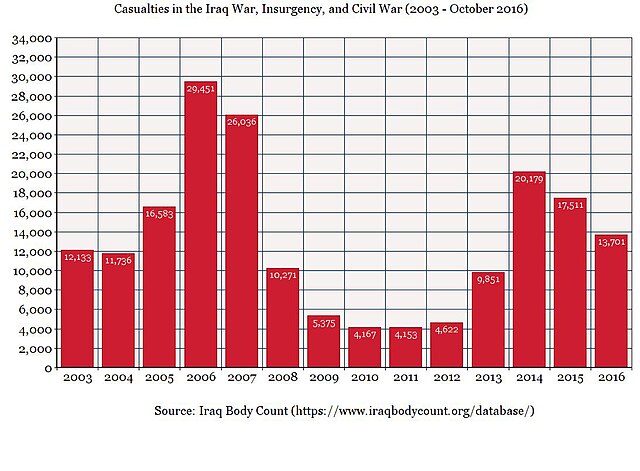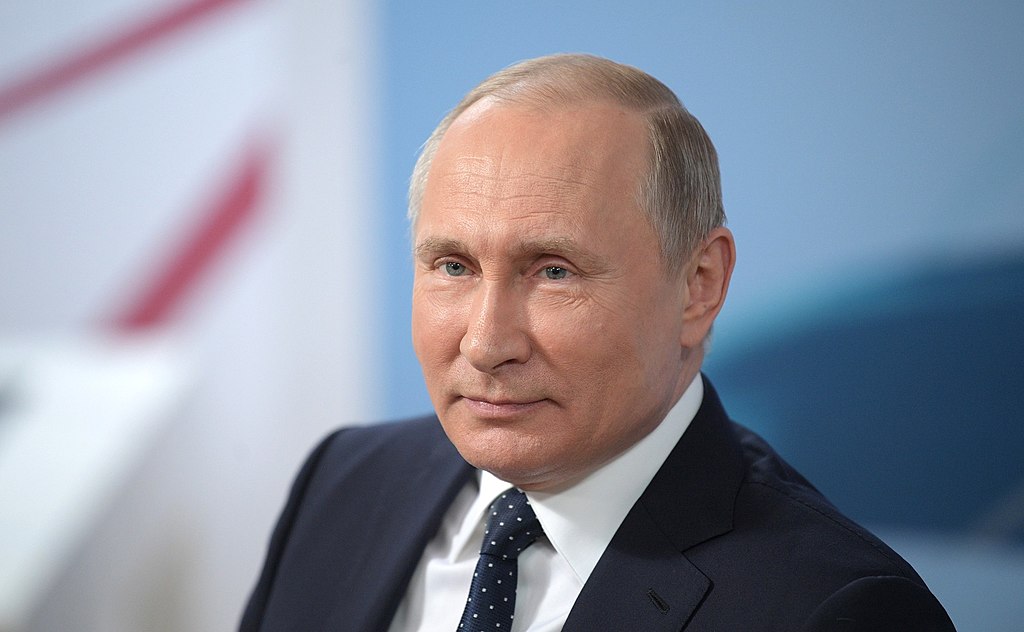We have the free, democratic, pure, clean, freedom of speech US with presidents who wouldn’t hurt a fly. No death toll.
Then we have a dictator-like evil Vladimir Putin who is a war criminal par excellence.
While Putin is really what he is, I want to make the case that the US is worse in absolute terms (meaning if Russia had such a power, its death toll would be greater, that goes without saying).
But we must have at least A Beginner’s Guide to Critical Thinking. We have to be devoid of cognitive biases, fallacies, and formal fallacies. It is called objectivity, being unbiased in order to find the truth.
Death toll? Let’s do the fact-check

I am not saying China or Russia would be better rulers than the US. Definitely not, even though the US style is deeply flawed. So how many people did it cripple or kill?
War on Terror? Death toll: 4.5 million people

If I kill one Slovak man, the Slovaks would kill a million Czechs (I am genetically Czech). I mean it, if we were to accept tribalism as something acceptable (which, of course, it isn’t). Sound strange? This is exactly what the US did in its War on Terror because of 9/11.
The U.S.-led War on Terror, initiated in response to the 9/11 attacks, has had profound and far-reaching consequences, particularly in the Middle East. Since 2001, U.S. military operations in countries such as Afghanistan, Iraq, Syria, Libya, Yemen, Somalia, and Pakistan have contributed to the deaths of an estimated 4.5 million people, either directly or indirectly.

These conflicts have also led to the displacement of millions, creating humanitarian crises that continue to this day. The Los Angeles Times noted that “U.S. military forces have been at war for all eight years of Obama’s tenure, the first two-term president with that distinction.” The ongoing violence and instability in these regions have raised serious questions about the effectiveness of the War on Terror and whether it has achieved its intended goals. The human cost of these wars, in terms of lives lost and communities destroyed, remains a significant and tragic legacy of U.S. foreign policy.
How many people were crippled?
The exact number of people who have been severely injured due to the War on Terror is difficult to quantify precisely. Many sources focus on fatalities rather than injuries or disabilities. However, the number of civilians and military personnel who have been left with permanent injuries is vast.
Millions of civilians have been injured during the conflicts in Afghanistan, Iraq, Syria, and other regions affected by the War on Terror. Estimates suggest that between 3 and 5 million civilians have been severely wounded. Many permanently disabled from bombings, airstrikes, and landmines. The scale of these injuries is immense, with entire communities affected by the long-term consequences of war.
Tens of thousands of soldiers from the U.S. and allied forces have also been severely injured. Data suggests that between 50,000 and 100,000 military personnel were wounded in combat during the wars in Iraq and Afghanistan. Many of these soldiers live with amputations, traumatic brain injuries, and other life-changing conditions. The toll on military personnel is immense, with injuries that impact their ability to return to normal life.
The psychological impact of the War on Terror has been just as damaging. Both civilians and soldiers have faced severe trauma, leading to conditions like PTSD, depression, and anxiety. Millions are estimated to suffer from these psychological injuries. This has lasting effects on their ability to work, socialize, or live independently. When factoring in both physical and mental harm, the total number of people significantly affected by the War on Terror could be as high as 10 million globally.
The Middle East targeted killings
Targeted killings in the Middle East by the United States have become a key component of its counterterrorism strategy. Particularly in the years following the September 11, 2001, terrorist attacks. This approach, which involves the deliberate targeting of individuals deemed to be terrorists or threats to U.S. national security, has largely been carried out through drone strikes and special operations missions.
These killings are designed to eliminate high-value targets, including leaders of terrorist organizations like al-Qaeda, ISIS, and the Taliban. The Obama administration significantly expanded the use of drone strikes in countries like Yemen, Pakistan, and Somalia. They justified these actions as necessary to combat global terrorism. However, this approach has sparked intense debate and controversy over its legality, effectiveness, and humanitarian impact, especially regarding civilian casualties. Between 2004 and 2020, estimates suggest that U.S. drone strikes in Pakistan, Yemen, and Somalia have resulted in the deaths of between 900 and 2,200 civilians, with around 300-900 of these being non-combatants, including children.
Dubious elimination
The U.S. government has defended targeted killings as an essential tool in neutralizing imminent threats and dismantling terrorist networks. Proponents argue that by eliminating key leaders, the U.S. can weaken organizations before they can carry out large-scale attacks on American soil or against its allies. High-profile operations, such as the killing of al-Qaeda leader Osama bin Laden in Pakistan in 2011 and Iranian General Qassem Soleimani in Iraq in 2020, are seen as major successes in this strategy.
The U.S. views these strikes as precision-based, minimizing the need for large-scale military interventions that could lead to higher American and civilian casualties (yes, the US death toll). However, reports from various human rights organizations highlight the unintended consequences of these operations. Particularly when drone strikes result in the deaths of innocent civilians. The Bureau of Investigative Journalism reports that civilian deaths from drone strikes have often been underreported. Civilian casualty figures sometimes exceeding official estimates, which fuels anti-American sentiment and contributes to further radicalization.
Low-profile criticism
The legality and ethical implications of targeted killings have been widely debated, especially in terms of international law and the sovereignty of the nations where these strikes occur. Critics argue that targeted killings often violate international legal norms. Especially when they take place in countries where the U.S. is not officially at war, such as Yemen and Somalia.
These critics claim that the U.S. lacks transparency and accountability in its drone strike program, with many strikes happening covertly. This makes it difficult to assess the actual number of civilian casualties. Human rights organizations estimate that in some areas, the proportion of civilians killed in strikes may be as high as 30%. The long-term impact of these killings has also raised questions about their effectiveness in achieving lasting peace and security. Some analysts suggest that while targeted killings remove immediate threats, they do little to address the underlying causes of terrorism, such as poverty, political instability, and foreign occupation, potentially making the Middle East more volatile in the long run.
Some torture? Yes, black sites do the deal
U.S. black sites refer to secret prisons operated by the Central Intelligence Agency (CIA) outside of the United States, where detainees were held in secret and subjected to harsh interrogation techniques during the War on Terror. These sites were located in various countries, including Afghanistan, Poland, Romania, and Thailand. They were part of the CIA’s extraordinary rendition program. It involved capturing suspected terrorists and transporting them to these facilities for interrogation.
One of the most horrific aspects of the black sites was the use of “enhanced interrogation techniques”. Many human rights organizations and legal experts have classified these as torture. These techniques included waterboarding, a practice in which water is poured over a detainee’s face to simulate drowning. Other forms of abuse included sleep deprivation, stress positions, confinement in small boxes, and exposure to extreme temperatures. Some detainees were subjected to continuous interrogations lasting days without rest, as well as physical assaults and sexual humiliation. The CIA’s own records reveal that detainees endured such brutal treatment that at least one person, Gul Rahman, died from hypothermia in a CIA black site in Afghanistan after being left half-naked in freezing temperatures.
Extrajudicial detention, torture or killing
Many detainees held at black sites were never charged with a crime. And some were later found to have been wrongfully detained. The lack of oversight and the secrecy surrounding these operations meant that abuses went unchecked for years. Khalid Sheikh Mohammed, the alleged mastermind of the 9/11 attacks, was waterboarded 183 times. While Abu Zubaydah, another detainee, endured such severe torture that he lost an eye. Despite years of legal battles and investigations, the full extent of what happened in these black sites remains shrouded in secrecy. The psychological and physical scars left on the detainees, many of whom were released without charge, have raised serious ethical and legal questions about the U.S. government’s conduct in the War on Terror. The use of black sites has been condemned by human rights groups worldwide as one of the darkest chapters of U.S. counterterrorism practices.
The War on Drugs

The Mexican Drug War, which escalated in 2006 when President Felipe Calderón deployed the military to combat drug cartels, has resulted in over 300,000 homicides related to organized crime. This includes cartel members, law enforcement officers, and countless innocent civilians caught in the crossfire.
Please note it was the US that started this whole war (through soft and hard power).
In Colombia, the decades of conflict involving the government, paramilitary groups, and drug cartels like the Medellín and Cali cartels. It led to tens of thousands of deaths. The violence peaked during the 1980s and 1990s but continues to claim lives today.
In the Philippines, since President Rodrigo Duterte launched his anti-drug campaign in 2016, it is estimated that over 12,000 people have been killed in extrajudicial killings. Human rights organizations suggest the number could be much higher, with many victims being low-level offenders or innocents.
Also, Afghanistan has experienced violence related to both the Taliban’s involvement in the drug trade and counter-narcotics operations by international and Afghan forces, resulting in numerous casualties.
The total number of violent deaths related to the War on Drugs globally can be roughly at around 500,000.
Of course, drug use would rise if the War on Drugs ceased to exist. But if we implement significant health initiatives, drug use will actually decrease.
The issue is that all the violence, incarcerated people, torture, and nearly failed states cease to be.
The whole failed war is just because the cartels are laundering their money via the Big Banks.
There are a lot of killers. You think our country’s so innocent?
This is not a quote of some conspiracy theorist, but the claim of the former and maybe future president of the United States, Mr. Donald Trump.
Since my blog heavily criticizes the US, they may kill me and I wouldn’t be the first and the last.
Shady special OPs
U.S. Special Operations forces are elite military units tasked with high-risk missions such as counterterrorism, hostage rescues, and targeted killings. They include Navy SEALs, Delta Force, Green Berets, and Army Rangers. All known for their specialized training and ability to operate in hostile or politically sensitive environments. These forces have been central to significant operations like the 2011 raid that killed Osama bin Laden. And they often conduct covert missions, gather intelligence, and train foreign militaries.
While Special Ops are highly effective and celebrated for their precision, they have also faced criticism. Civilian casualties during raids, the secrecy surrounding their missions, and their involvement in controversial conflicts or with groups that have questionable human rights records have drawn scrutiny. Critics argue that their covert operations sometimes lack transparency and accountability. This raised ethical and legal concerns about U.S. military practices abroad.
Why the killing machine US is doing what it does?
All of it is because of the Big Banks, super-rich families, the Military-industrial complex, and their criminal-minded interests.
They want to control the whole economies, banking, and financial systems. Natural resources, sensitive technologies.
Well, if they kill some people (or millions of them), it is just collateral damage.
Yes, Vladimir Putin is evil, though not a psychopath
Vladimir Putin has been ruling Russia for a really long time. And of course, with an expansive, imperial, and war-mongering attitude.
He is a strong nationalist, cruel, introverted person and has psychopathic traits, but psychopathy or sociopathy is something different. We must acknowledge that wars, torture, and massive human rights breaches are deeply rooted in Russian culture (this is not an apologetic claim).
Comparing the Russian death toll

Estimating the exact number of people killed or crippled during Vladimir Putin’s time in power is challenging due to the complexity of various conflicts and actions taken under his leadership. This includes the invasion of Ukraine, as well as other military actions and political repressions. Early in his presidency, Putin oversaw the brutal Second Chechen War, which resulted in an estimated 25,000 to 50,000 civilian deaths, with many more severely injured. Thousands of soldiers and militants also died or suffered lasting physical and psychological wounds.
Political repression under Putin has also contributed to a number of killings and injuries. Numerous political opponents, journalists, and activists have been assassinated or seriously harmed. High-profile cases like the murders of journalist Anna Politkovskaya and opposition leader Boris Nemtsov stand out, but there are countless others. Human rights groups have tracked these killings, adding to a broader climate of fear and violence. While it’s difficult to pinpoint an exact number, political repression under Putin has claimed dozens of lives, and many others have been left injured or intimidated.
Russian deadly Middle East mission
Russia’s involvement in the Syrian Civil War added to the death toll. Beginning in 2015, Russian airstrikes killed an estimated 23,000 civilians, many in indiscriminate bombing campaigns. Russia’s intervention left thousands more severely injured, as the conflict ravaged cities and destroyed infrastructure. The ongoing invasion of Ukraine, which began in February 2022, has resulted in staggering casualties. Estimates suggest that hundreds of thousands of people, including soldiers and civilians, have died as a result of the conflict.
Ukrainian sources and international organizations report that tens of thousands of civilians have been killed, while military deaths on both sides add significantly to the toll. The war has displaced millions and left hundreds of thousands injured or maimed by the relentless violence. When counting both the direct and indirect casualties of Putin’s military actions, political repression, and wars, the total death toll could be in the hundreds of thousands, with millions more suffering from physical and psychological harm.
Putin will, no doubt, kill more people, but he hasn’t surpassed Obama and Bush yet
Once again, I am a strong human rights supporter and despise all of the violence. But I am – and this is a great exemption – impartial.
Even if I were an American, I would count one dead body from each side as equal. And I wouldn’t consider POTUS as someone good and I wouldn’t scream “USA! USA!” with all the killing machine being on.
Comparing both death tolls
If I am able to count, the aforementioned numbers are as follows: around 5 million dead people caused by the US, while Putin’s numbers are nearing one million.
While Putin is really what I described, the US is a war-mongering, clientelism-ridden (gross corruption, Big Banks, super-rich families) country that is not repulsed by killing, crippling, or torturing millions.
Sadly, people would have to look up the word “impartial” in the dictionary. If he kills tens of thousands, let’s stone him to death! Is it us who are killing? That simply doesn’t count.”

Leave a Reply